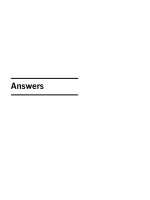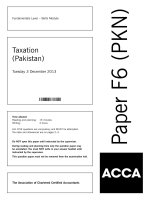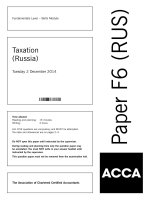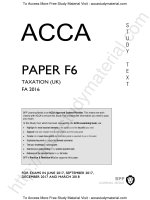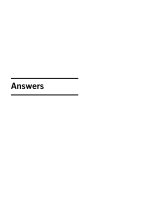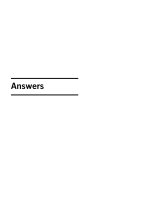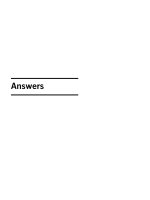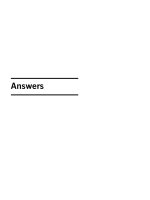ACCA f6 taxation uk 2014 dec answer
Bạn đang xem bản rút gọn của tài liệu. Xem và tải ngay bản đầy đủ của tài liệu tại đây (249.87 KB, 9 trang )
Answers
Fundamentals Level – Skills Module, Paper F6 (UK)
Taxation (United Kingdom)
December 2014 Answers
and Marking Scheme
Marks
1
(a)
Alfred King – Income tax computation 2013–14
£
72,750
2,600
–––––––
75,350
(9,440)
–––––––
65,910
–––––––
Trading profit (working 1)
Dividends (2,340 (3,060 – 720) x 100/90)
Personal allowance
Taxable income
£
34,410 (working 3) at 20%
28,900 (65,910 – 2,600 – 34,410) at 40%
2,600 at 32·5%
–––––––
65,910
–––––––
Income tax liability
Tax suffered at source – Dividends (2,600 x 10%)
6,882
11,560
845
–––––––
19,287
(260)
–––––––
19,027
3,659
–––––––
22,686
(20,200)
–––––––
2,486
–––––––
Income tax payable
Class 4 national insurance contributions (working 4)
Payments on account
Balancing payment
W1
1
½
W3 ½
½
½
½
W4
½
Working 1 – Trading profit
£
228,000
(34,000)
––––––––
194,000
––––––––
Trading profit
Capital allowances (working 2)
Profit share
6 April to 31 December 2013
1 January to 5 April 2014
194,000 x 9/12 x 1/3
194,000 x 3/12 x 1/2
48,500
24,250
–––––––
72,750
–––––––
½
W2
1
1
Working 2 – Capital allowances
£
WDV brought forward
Additions qualifying for AIA
False ceiling
Display units
Tiled flooring
Movable partitions
AIA – 100%
0
15,100
0
17,100
–––––––
32,200
(32,200)
–––––––
WDA – 18%
Main pool
£
10,000
Total allowances
½
½
½
½
½
0
(1,800)
–––––––
8,200
–––––––
WDV carried forward
Allowances
£
32,200
½
1,800
½
–––––––
34,000
–––––––
Tutorial note: Expenditure forming part of a building, such as the false ceiling and tiled flooring, does not
qualify as plant. The display units and the movable partition walls are not treated as forming part of the
shop building, and therefore qualify as plant.
Working 3 – Tax band
(1) Alfred’s basic rate tax band is extended by £2,400 (1,920 x 100/80) to £34,410 (32,010 + 2,400)
as a result of making the gift aid donations.
17
1
Marks
Working 4 – Class 4 national insurance contributions
(1) Class 4 NIC for 2013–14 is £3,659 ((41,450 – 7,755 = 33,695 at 9%) + (72,750 – 41,450 =
31,300 at 2%)).
1½
Edward King – Income tax computation 2013–14
£
Employment income
Director’s remuneration
Pension contributions (179,000 x 4%)
Charitable payroll deductions (12 x 200)
179,000
(7,160)
(2,400)
––––––––
169,440
1,160
2,200
––––––––
172,800
(800)
(240)
––––––––
171,760
0
––––––––
171,760
––––––––
Beneficial loan (87,000 x 4/12 at 4%)
Home entertainment system (working 1)
Mileage allowance (working 2)
Professional subscription
Personal allowance
Taxable income
£
32,010 at 20%
117,990 at 40%
21,760 at 45%
––––––––
171,760
––––––––
Income tax liability
Tax suffered at source – PAYE
½
1
1
1
W1
W2
1
½
6,402
47,196
9,792
––––––––
63,390
(62,600)
––––––––
790
––––––––
Balancing payment
1
½
Working 1 – Home entertainment system
(1) Edward will have been taxed on benefits totalling £3,120 (5,200 x 20% x 3) for the tax years
2010–11, 2011–12 and 2012–13.
1
(2) The benefit for the acquisition of the home entertainment system in 2013–14 is the market value at
the date of gift of £2,200, as this is greater than £2,080 (5,200 – 3,120).
1½
Working 2 – Mileage allowance
£
Mileage allowance received 12,000 at 35p
Less: 10,000 miles at 45p
2,000 miles at 25p
£
4,200
4,500
500
––––––
(5,000)
––––––
(800)
––––––
(b)
(i)
(1) Unless the return is issued late, the latest date when Alfred can file his self-assessment tax return
online for 2013–14 is 31 January 2015.
(2) If Edward completes a paper tax return by 31 October 2014, then HM Revenue and Customs will
prepare a self-assessment tax computation on his behalf.
(ii)
(1) As Alfred was in business during 2013–14, all of his tax records (both business and non-business)
must be retained until five years after 31 January following the tax year, which is 31 January
2020.
(2) As Edward was not in business during 2013–14, his tax records must be retained until one year
after 31 January following the tax year, which is 31 January 2016.
18
½
½
½
–––
23
–––
1
1
–––
2
–––
1
1
–––
2
–––
Marks
(c)
(1) If one full-time employee is employed on an annual salary of £22,000, then employer’s class 1 NIC
would be £1,974 (14,304 (22,000 – 7,696) at 13·8%).
(2) The total employment cost would be £23,974 (22,000 + 1,974).
½
(3) If two part-time employees are employed on annual salaries of £11,450, then the total employer’s
class 1 NIC would be £1,036 (3,754 (11,450 – 7,696) at 13·8% = 518 x 2).
(4) The total employment cost would be £23,936 (22,900 (11,450 x 2) + 1,036).
2
1
1
½
–––
3
–––
30
–––
E-Commerce plc
(a)
(i)
Corporation tax computation for the year ended 31 March 2014
£
Operating profit
Legal fees – Issue of preference shares
– Issue of loan notes
– Renewal of long lease
– Breach of contract
– Registration of trade marks
£
2,102,300*
80,200
0
14,900
0
0
––––––––
½
½
½
½
½
95,100
––––––––––
2,197,400
(11,520)
Deduction for lease premium (14,400 x 12/15)
Capital allowances
Motor car [1]
Motor car [2]
Motor car [3] (62,100 x 10% (18% – 8%)
Motor car [4] (19,800 x 82% (100% – 18%)
Short-life asset (1,512 x 82/18)
209,200*
0
0
(6,210)
16,236
6,888
––––––––
1
½
½
1
1
1
(226,114)
––––––––––
1,959,766
Trading profit
Property business profit
Repairs (capital in nature)
Rent accrual – March 2014 (16,200 x 1/3)
156,700*
95,300
5,400
––––––––
1
1
257,400
Loan interest receivable
Accrual (4,800 – 3,500)
42,400*
(1,300)
––––––––
1
Taxable total profits
41,100
––––––––––
2,258,266
––––––––––
Corporation tax (2,258,266 at 23%*)
519,401
––––––––––
*Figures provided in question
½
1
–––
12
–––
Tutorial notes:
(1) Motor cars [1] and [2] have CO2 emissions between 96 and 130 grams per kilometre, and
qualify for writing down allowances at the rate of 18%. No adjustment is therefore required.
(2) Motor car [3] has CO2 emissions over 130 grams per kilometre, and therefore only qualifies for
writing down allowances at the rate of 8%.
(3) Motor car [4] has CO2 emissions up to 95 grams per kilometre, and therefore qualifies for the
100% first year allowance.
(4) The scrapping of the computer equipment is a disposal for capital allowances purposes. The
company should therefore have received a 100% balancing allowance rather than a writing down
allowance at the rate of 18%. The 82/18 adjustment represents the additional 82% (100% –
18%) of the brought forward WDV which can be deducted.
19
Marks
(ii)
(1) Large companies have to make quarterly instalment payments in respect of their corporation tax
liability. A large company is one paying corporation tax at the main rate.
1
(2) However, a company is not required to make quarterly instalment payments in the first year that
it is large. Therefore, E-Commerce plc will not have been required to make instalment payments
for the year ended 31 March 2014 as it was not a large company in the year ended 31 March
2013. This is because the augmented profits of £1,360,000 were less than £1,500,000.
1
(3) For the year ended 31 March 2015, this exception will not apply. Therefore, E-Commerce plc will
have to make quarterly instalment payments as it will be paying corporation tax at the main rate.
(b)
(i)
(1) E-Commerce plc has already defaulted twice during the current default surcharge period, so a
further default will result in a surcharge of 10% of the amount of VAT outstanding.
1
(2) In addition, the default surcharge period will be extended to the 12-month anniversary of the VAT
quarter to which the default relates.
1
(3) In order to revert to a clean default surcharge record, E-Commerce plc will need to submit four
consecutive VAT returns on time and also pay the related VAT liabilities on time.
(ii)
(1) VAT should be accounted for on the earlier of the date when the service is completed and the date
the service is paid for.
(2) Output VAT at the UK VAT rate should be declared on the UK business’s VAT return. This will then
be reclaimed as input VAT on the same VAT return, so the effect will be VAT neutral. This is known
as the reverse charge procedure.
(iii) (1) E-Commerce plc will be permitted to disclose the underpayment of VAT of £8,200 by entering this
amount on its next VAT return as the net error is less than the limit of £10,000.
(2) Default interest is not charged where voluntary disclosure can be made by entering the
underpayment on the next VAT return.
(iv) (1) E-Commerce plc has been careless in its incorrect treatment of the supply of services received, so
the maximum amount of penalty will therefore be 30% of the VAT underpaid (8,200 x 30% =
£2,460).
(2) However, this penalty could be reduced to nil as a result of the company’s unprompted disclosure
to HM Revenue and Customs.
3
(a)
1
–––
3
–––
(1) Patrick and Emily have been resident in the UK during the three previous tax years, and will be in the
UK between 91 and 120 days.
(2) They are therefore resident in the UK for 2013–14 as a result of them each having two UK ties.
(3) The UK ties are having a house in the UK which is made use of, and being in the UK for more than
90 days during the previous two tax years.
Tutorial note: For 2013–14, Patrick and Emily have spent too long in the UK to be automatically treated as
non-resident, and will not automatically be treated as resident because they do not meet the only home
test.
20
1
–––
3
–––
1
2
–––
3
–––
1
1
–––
2
–––
1
1
–––
2
–––
25
–––
1
½
1½
–––
3
–––
Marks
(b)
Alternative 1 – Land (Patrick)
£
92,000
(63,240)
–––––––
28,760
(10,900)
–––––––
17,860
–––––––
3,215
–––––––
88,785
–––––––
Disposal proceeds
Cost
Annual exempt amount
Capital gains tax: 17,860 at 18%
Net of tax proceeds (92,000 – 3,215)
½
W
½
½
½
Working – Cost
(1) The base cost used in the earlier part disposal of the six acres of land is £45,360 (108,600 x
37,800/90,500 (37,800 + 52,700)). Therefore, the base cost relating to the eight unsold acres of
land is £63,240 (108,600 – 45,360).
1½
Alternative 2 – Unquoted shares (Emily)
£
92,000
(8,000)
–––––––
84,000
0
–––––––
84,000
–––––––
8,400
–––––––
83,600
–––––––
Disposal proceeds (8,000 at £11·50)
Cost (8,000 at £1·00)
Annual exempt amount
Capital gains tax: 84,000 at 10%
Net of tax proceeds (92,000 – 8,400)
1
½
½
1
½
Tutorial notes:
(1) The disposal proceeds are based on £11·50 per share, as given the need for a quick sale there is no
reason to believe that this is not a bargain at arm’s length.
(2) The disposal will qualify for entrepreneurs’ relief as Emily is a director of Shore Ltd, Shore Ltd is a
trading company, and her shareholding of 8% (8,000/100,000 x 100) is more than the minimum
required holding of 5%.
Alternative 3 – Quoted shares (jointly)
£
92,160
(44,800)
–––––––
47,360
–––––––
23,680
(10,900)
–––––––
12,780
–––––––
23,680
0
–––––––
23,680
–––––––
2,300
6,630
–––––––
8,930
–––––––
83,230
–––––––
Disposal proceeds (32,000 at £2·88)
Cost (75,600 x 32,000/54,000)
Patrick – 50%
Annual exempt amount
Emily – 50%
Annual exempt amount
Capital gains tax: 12,780 at 18%
23,680 at 28%
CGT liability
Net of tax proceeds (92,160 – 8,930)
½
1
½
½
½
½
½
½
Conclusion
(1) Alternative 1 (selling the land) will result in the highest net proceeds after taking account of capital gains
tax.
21
½
–––
12
–––
15
–––
Marks
4
(a)
Corporation tax saving for the year ended 31 March 2014
Retail shop run by Banjul Ltd as a subsidiary company
Accra Ltd
£
244,000
––––––––
Trading profit
Corporation tax (244,000 at 23%)
Marginal relief (working)
3/400 (750,000 – 244,000)
56,120
(3,795)
––––––––
52,325
––––––––
½
W½
Banjul Ltd
Trading profit
£
36,000
–––––––
Corporation tax (36,000 at 20%)
7,200
–––––––
½
Trading profit (244,000 + 36,000)
£
280,000
––––––––
½
Corporation tax (280,000 at 20%)
56,000
––––––––
½
Retail shop run by Accra Ltd as part of existing business
The amount of corporation tax which would have been saved is £3,525 (59,525 (52,325 + 7,200) –
56,000).
½
Working – Upper limit
(1) Following the formation of Banjul Ltd, Accra Ltd has one associated company. The lower and upper
limits will therefore be reduced to £150,000 (300,000/2) and £750,000 (1,500,000/2) respectively.
(b)
(i)
1
–––
4
–––
Cairo Ltd – Maximum group relief claim
Corresponding period ended 30 November 2013 (eight months)
Dakar Ltd loss (54,600 x 8/12)
£
36,400
–––––––
½
Cairo Ltd profit (87,000 x 8/12)
58,000
–––––––
½
Group relief is restricted to the lower figure of £36,400.
½
Corresponding period ended 31 March 2014 (four months)
Dakar Ltd – Trading loss
– Capital loss
– Qualifying charitable donations
Cairo Ltd profit (87,000 x 4/12)
£
27,900
0
3,600
–––––––
31,500
–––––––
½
½
29,000
–––––––
½
Group relief is restricted to the lower figure of £29,000.
½
Claim for the year ended 31 March 2014
The maximum group relief claim by Cairo Ltd in respect of the year ended 31 March 2014 is therefore
£65,400 (36,400 + 29,000).
Tutorial note: Unrelieved qualifying charitable donations can be group relieved, but it is not possible
to surrender capital losses in a group loss relief claim.
22
½
–––
4
–––
Marks
(ii)
(1) A group relief claim results in earlier relief, since Dakar Ltd will not make a trading profit until the
year ended 31 March 2015.
½
(2) Although a group relief claim only saves corporation tax at the small profits rate of 20% (given
Cairo Ltd’s level of profits), Dakar Ltd will also be paying tax at the same small profits rate for the
year ended 31 March 2015.
1
(3) A group relief claim avoids wasting all of Dakar Ltd’s qualifying charitable donations for the period
ended 31 March 2014.
(c)
(i)
(1) Maputo Ltd is included in the chargeable gains group as there is a 75% shareholding at each level
and an effective interest of 80% (80% x 100%).
(2) Niamey Ltd is not included in the chargeable gains group as Maputo Ltd does not own at least
75% of Niamey Ltd.
(ii)
£
£
310,000
120,000
42,000
––––––––
(162,000)
––––––––
148,000
(84,240)
––––––––
63,760
––––––––
Indexation 162,000 x 0·520
Chargeable gain
(iii) The reinvestment must take place during the period 1 June 2012 (one year before the date of disposal)
to 31 May 2016 (three years after the date of disposal).
(a)
1
1
–––
2
–––
Kigali Ltd – Chargeable gain
Disposal proceeds
Cost
Enhancement expenditure
5
½
–––
2
–––
½
½
½
½
–––
2
–––
1
–––
15
–––
Mildred – Inheritance tax on death estate
£
Property
Interest-only mortgage
Portfolio of ordinary shares
Motor car
Credit card debts
Medical costs
Funeral expenses
£
660,000
(94,300)
––––––––
565,700
192,600
21,900
––––––––
780,200
9,400
0
5,800
––––––
½
1
½
½
½
½
½
(15,200)
––––––––
765,000
––––––––
Chargeable estate
Inheritance tax liability 455,000 (working) at nil%
310,000 at 40%
0
124,000
––––––––
124,000
––––––––
W
½
Tutorial note: The promise to pay the friend’s medical costs is not deductible as it is not legally enforceable.
Working – Nil rate band
(1) Mildred’s personal representatives will have claimed her deceased husband’s unused nil rate band of
£130,000 (325,000 x 40%).
(2) The total amount of nil rate band is therefore £455,000 (325,000 + 130,000).
23
1
½
Marks
Tobias – Inheritance
Tobias will have inherited £616,000 (765,000 – 25,000 – 124,000).
1
–––
7
–––
Tutorial note: In practice, Mildred’s personal representatives may well honour the promise to pay the friend’s
medical costs. In this case, the inheritance will be £611,400 (616,000 – 4,600). Students are not
expected to know this, although equivalent marks will be awarded for taking this approach.
(b)
(1) There is no maximum limit to the amount of additional personal pension contribution which Tobias
could make for 2013–14.
½
(2) The maximum contribution which will qualify for tax relief is £68,000 (relevant earnings of £78,000
less the £10,000 of contributions already made).
1
(3) However, tax relief will effectively be restricted to the available annual allowances of £64,000 (£24,000
(50,000 – 26,000) from 2012–13 and £40,000 (50,000 – 10,000) from 2013–14).
(c)
(1) The gift will be a potentially exempt transfer of £89,000 (£100,000 less the marriage exemption of
£5,000 and annual exemptions of £3,000 for 2013–14 and 2012–13).
(2) If Tobias dies before 29 March 2021 (within seven years of making the gift), then the amount of nil
rate band available against his estate will be reduced by £89,000.
(d)
(1) Since Tobias has already invested £2,400 into a cash ISA, he can invest a maximum of £9,120
(11,520 – 2,400) into a stocks and shares ISA in 2013–14.
(2) Alternatively, he could invest up to a further £3,360 (5,760 – 2,400) into a cash ISA, with the balance
of £5,760 being invested into a stocks and shares ISA.
Tutorial note: Tobias could also invest the maximum limit of £11,520 into a stocks and shares ISA by
transferring his existing cash ISA. However, ISA transfers are outside the scope of the F6(UK) syllabus.
24
1½
–––
3
–––
2
1
–––
3
–––
1
1
–––
2
–––
15
–––
